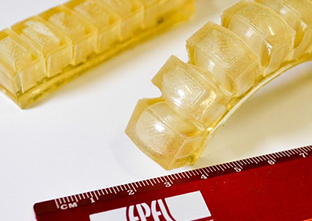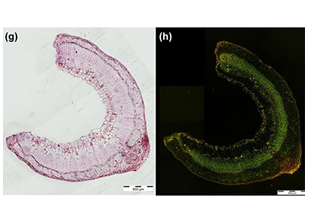Polymers can act as catalysts in our research

Tell us about your career in a few words.
Around a decade ago, I obtained a PhD in evolutionary biology. Since then, I have been conducting research and seeking interactions between my discipline and others, such as sociology, engineering, chemistry and mathematics. This is one of the reasons that led me to the École polytechnique fédérale de Lausanne (EPFL) which, as its name indicates, is multidisciplinary. As a biomimicry expert, I find myself at the intersection of many disciplines, and I am glad to find that, with biomimicry, it is biology which enriches other scientific disciplines. Before seeking inspiration from nature, it is necessary to first understand how it works. And that can be difficult, as nature also changes, and has been doing so for close to four billion years.

What are your main areas of research at this time?
 At the EPFL, we are exploring several avenues. We are seeking to develop new materials, or find new way of producing energy, through new generations of solar panels, for instance. Finally, we also have a highly-developed robotics division. That makes sense, since it is where everything started. Let us not forget that the very basis of a robot’s existence involves reproducing the behaviours of living beings, better and more efficiently if possible. As a public institution, we are fortunate enough to be able to investigate scientific issues which may be of interest to private companies that are then willing to fund a portion of our work. As a result, we work with engineers, a category of professionals seeking more concrete and realistic solutions.
At the EPFL, we are exploring several avenues. We are seeking to develop new materials, or find new way of producing energy, through new generations of solar panels, for instance. Finally, we also have a highly-developed robotics division. That makes sense, since it is where everything started. Let us not forget that the very basis of a robot’s existence involves reproducing the behaviours of living beings, better and more efficiently if possible. As a public institution, we are fortunate enough to be able to investigate scientific issues which may be of interest to private companies that are then willing to fund a portion of our work. As a result, we work with engineers, a category of professionals seeking more concrete and realistic solutions.
You mentioned materials. How does one go about creating a new material inspired by nature?
 We cannot claim that we create new materials every time. Most often, we use existing materials and try to combine or mix them, taking inspiration from nature. A few months ago, we were contacted by ski manufacturer Stockli which was looking for a material able to make the skis extremely rigid in straight lines in order to improve performance, but yet sufficiently flexible and curved to make turning easy. Initially, one would be forgiven for thinking that they were two antagonistic properties. One of our researchers then recalled a conference which she attended on the subject of tortoise shells. She recalled that the way in which the scales were placed enabled the very rigid shell to remain flexible when the animal breathes. After conducting several studies, we decided to place an aluminium plate with a zig-zag-shaped slit glued to an elastomer inside the ski. The slit and the elastomer provide sufficient flexibility to enable the ski to make quick and precise turns. This is just one example among many. We are currently looking at reproducing the self-cleaning properties of rose petals.
We cannot claim that we create new materials every time. Most often, we use existing materials and try to combine or mix them, taking inspiration from nature. A few months ago, we were contacted by ski manufacturer Stockli which was looking for a material able to make the skis extremely rigid in straight lines in order to improve performance, but yet sufficiently flexible and curved to make turning easy. Initially, one would be forgiven for thinking that they were two antagonistic properties. One of our researchers then recalled a conference which she attended on the subject of tortoise shells. She recalled that the way in which the scales were placed enabled the very rigid shell to remain flexible when the animal breathes. After conducting several studies, we decided to place an aluminium plate with a zig-zag-shaped slit glued to an elastomer inside the ski. The slit and the elastomer provide sufficient flexibility to enable the ski to make quick and precise turns. This is just one example among many. We are currently looking at reproducing the self-cleaning properties of rose petals.
And a conference once again came to mind?
Unfortunately not. That type of coincidence is fairly rare in our line of work. However, the world’s scientists have access to large databases, such as Google Scholar, Pubmed, Ask Nature, and others. In the end, our research is twofold: the first part, such as the ski, is linked to a request. We then look at the types of solutions that nature can offer. The second part is the opposite. We note a characteristic found in nature, we study it, we try to model it, and we then see whether we can design a material with the same properties.

What place do polymers occupy in such materials?
 Their role has become increasingly important, in particular since the advent of 3D printers. We can use polymers to create extremely complex shapes. However, this is not their only advantage. Our understanding of these materials is constantly improving, and they are constantly being developed further. They are synthetic materials, designed by man, and the chemists and engineers working in the industry are able to penetrate the heart of the materials. There have been incredible developments in the field of nanotechnology over the past years, and it is now possible to change a polymer’s properties simply by enriching it with a given nanomaterial. As a result, we can use a single polymer to reproduce a duck’s beak which will be flexible at the point at which it attaches to the head and very hard at the end.
Their role has become increasingly important, in particular since the advent of 3D printers. We can use polymers to create extremely complex shapes. However, this is not their only advantage. Our understanding of these materials is constantly improving, and they are constantly being developed further. They are synthetic materials, designed by man, and the chemists and engineers working in the industry are able to penetrate the heart of the materials. There have been incredible developments in the field of nanotechnology over the past years, and it is now possible to change a polymer’s properties simply by enriching it with a given nanomaterial. As a result, we can use a single polymer to reproduce a duck’s beak which will be flexible at the point at which it attaches to the head and very hard at the end.
 Polymers also enable us to “play” with functionalities. Many laboratories are seeking nanostructures that can change a material’s colour. Some insects are able to do this! This would enable us to stop using certain pigments that are not environmentally-friendly. Finally, there is our Holy Grail: the fingers of the gecko, the small lizard able to walk on any ceiling thanks to the structure of its feet.
Polymers also enable us to “play” with functionalities. Many laboratories are seeking nanostructures that can change a material’s colour. Some insects are able to do this! This would enable us to stop using certain pigments that are not environmentally-friendly. Finally, there is our Holy Grail: the fingers of the gecko, the small lizard able to walk on any ceiling thanks to the structure of its feet.
Do you think that there is a limit to biomimicry?
Possibly, but we have not reached it yet. We will have reached its limits when materials are able to react in the same way as that found in nature. For instance, when they can self-repair like bone, which is able to regenerate material in the event of a fracture. However, our knowledge is evolving very quickly, and nature’s resilience is such that we will almost certainly always find it difficult to solve all its mysteries.






